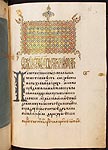Tetraevangelion. 1470s. 15th cent.
F (295 x 200). 328 leaves.
Paper. Ink, cinnabar, colours, gold.
It is written in a large semi-uncial hand.
The illumination of the manuscript includes 3 Evangelist portraits, executed in colours and gold (fols. 7v, 93v, 246v). Leaves with miniatures are glued to blank leaves of the codex. Protective silk curtains are placed before them. There are head-pieces and initials in the Balkan style, worked in colours and gold (fols. 2r, 9r, 95r, 153r, 248r, 312r). Large headings are written in gold with use of ligatures.
Some reseachers (E. Popov and T. Tolstaya) suppose that the Gospel contains miniatures which were painted at a much earlier date. The decorative patterns of the manuscriptis are of great interest and an evidence of the development of zoomorphic and anthropomorphic elements in the design of the 15th-century books. This can be traced in initial letters, decorated with figures of snakes, lizards etc. Especially frequent is the ornamental capital letter called "Zemlya" in the form of a winged dragon (fol. 100r).
In 1918 the manuscript came into the State Public Library along with the other materials from the library of the Kirillo-Belozersky Monastery, transferred from the St Petersburg Theological Academy.
Shelfmark: –Õ¡. Ë.-¡ÂÎ. 44/49.





